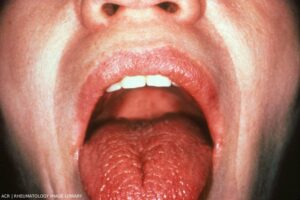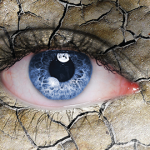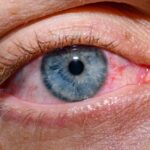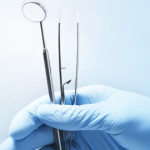
Dryness of the mouth and tongue from lack of salivary secretion is characteristic of xerostomia associated with Sjögren’s disease. Mouth dryness may produce a deep red tongue, as shown here, and dental caries are common. (Click to enlarge.)
Whether due to Sjögren’s disease or something else, dry mouth is a common chief complaint from patients with rheumatic illnesses. Dry mouth isn’t life-threatening, but it can have a serious impact on quality of life. Sialogogues like cevimeline and pilocarpine may benefit some, but not all, patients, but cholinergic side effects often limit their usefulness. Immunosuppressants have thus far not shown benefit. So what tips can we give patients desperate for relief? Good news. There are 10.
During a session at ACR Convergence 2022, Leslie P. Laing, PhD, DDS, president of the Sjögren’s Society of Canada, prosthodontist and immunologist, Toronto Public Health, Dental, and Oral Health Services, Toronto, shared excellent advice that remains valid for the management of dry mouth—or what I’m calling “the new science of hydrostomia.”
Top 10
- Massage the salivary glands. To massage the parotid glands, place fingers on the cheeks and milk the parotid gland in the anterior direction. Another option is sublingual gland massage, which can be performed by pushing the tongue down onto the two soft pillow-like structures on the floor of the mouth. “This is more discrete since you can do it with a closed mouth. In fact, I’m calling these oral Kegels,” Dr. Laing said.
- Use sugar-free, xylitol-containing gum or lozenges. Examples include the gum and lozenges from Pür or X-Pur, which are available for purchase online. Dr. Laing advised us to steer clear of sugar-free options containing aspartame that may be non-cariogenic but are drying.
- Store a cherry pit, plastic button or pebble in the mouth and move it around. “This will stimulate the mechanoreceptors in gingival tissues, resulting in increased saliva production,” explained Dr. Laing. Interestingly, this technique has been used since ancient times (e.g., by people crossing the desert) to wet the mouth, but has no benefit for hydration status.1-4
- Use Dr. John’s Herbal Lollipops or Loloz. “Even a patient with head and neck cancer can hold onto one of these [in the mouth] and get salivary stimulation,” said Dr. Laing. Her patients like the flavor with licorice root extract best. This flavor also had the greatest ability to reduce levels of Strep. mutans in an in vitro study.5,6 Licorice root extract “may potentially have beneficial effects in the treatment of autoimmune disease and oral caries, too.”
- Drink green tea. Green tea polyphenols may protect glandular acinar cells from autoimmune-induced damage in people with SJD.7 Dr. Laing added, “We’ve also observed a clinically significant increase in the salivary flow rate and statistically significant drop in salivary viscosity in people with SJD who drink green tea.6,8 It may help them feel more comfortable. The tea mug may also be used as a warm compress for the parotid gland.”
- Be moderate in water drinking, but stay hydrated. “Dry mouth isn’t the same as thirst. Water … doesn’t lubricate the mouth or the throat. And what little saliva is present is swallowed along with the water,” Dr. Laing said. Instead, patients can try ice chips, which may be more beneficial given the longer “staying power,” or an atomizer to spray water at the back of the throat.
- Wear removable prostheses, day or night. Dr. Laing explained, “Being a prosthodontist, I would be remiss if I didn’t talk about removable prostheses. Dentures that are fitted appropriately will cause some salivary flow via mechanical stimulation of the gums.9-14 Even a night guard or stabilization appliance—worn day or night—will help.”
- Oil-pull with virgin coconut oil. “It’s been shown that oil pulling, a traditional folk remedy practiced in ancient India for oral ailments, can be helpful for dry mouth because it reduces the oral microbial load significantly after just three weeks,” Dr. Laing said. Oil pulling may also reduce gingivitis, brighten teeth and improve halitosis.15,16 To perform oil pulling, take about one-half teaspoon of solid virgin coconut oil, put it in the mouth, and swish it around (pull and push it through the teeth) for about 90 seconds.
- Try commercially available remoisturizing or remineralizing aids. “The bioXtra products—available for online purchase—are especially good because they have bioenzymes in them. XyliMelts (Oral Science) are amazing for nighttime moisture. You just stick a disc on the gum above the upper molars,” Dr. Laing shared.
- Massage the gums with a Curaprox or Plumasoft toothbrush, or a Waterpik. According to Dr. Laing, “[Curaprox and Plumasoft] toothbrushes are extremely soft. Curaprox ones have the number 5460 on them, which indicates how many polyester bristles they have. If you brush them on the gums with no water or toothpaste, they’ll stimulate salivary flow. A Waterpik can do the same, while hydrating the mouth.”
Silver Diamine Fluoride
A talk from a dentist would be remiss without a comment on prevention of dental caries. Silver diamine fluoride (SDF) is a minimally invasive treatment for dentine hypersensitivity and carious lesions.17-19 It’s indicated for people at high risk of dental caries (e.g., those with xerostomia). “SDF effectively arrests the decay that previously plagues patients with dry mouth. This treatment, in combination with cosmetic bonding, improves dental aesthetics with minimal invasion and cost, increasing patients’ self-esteem,” Dr. Laing said.



